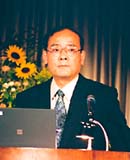 Considering
the results of the fusion of broadcasting and communications, the broadcasting
environment, broadcasting systems, and viewing styles will drastically
change in the future. This transition is supported by hardware development,
and new broadcasting systems cannot be constructed without the development
of new devices and materials. To facilitate this, future research on devices
will need to be advanced under the following four concepts: 1) devices
to enrich network-use broadcasting, 2) device technology toward the next
generation of media such as super reality broadcasting and 3-D TV, 3)
devices to realize highly efficient content production, and 4) human-
and environmentally-friendly devices. These devices range widely; I will
introduce below the direction of research in the areas of recording, imaging,
and displaying. Considering
the results of the fusion of broadcasting and communications, the broadcasting
environment, broadcasting systems, and viewing styles will drastically
change in the future. This transition is supported by hardware development,
and new broadcasting systems cannot be constructed without the development
of new devices and materials. To facilitate this, future research on devices
will need to be advanced under the following four concepts: 1) devices
to enrich network-use broadcasting, 2) device technology toward the next
generation of media such as super reality broadcasting and 3-D TV, 3)
devices to realize highly efficient content production, and 4) human-
and environmentally-friendly devices. These devices range widely; I will
introduce below the direction of research in the areas of recording, imaging,
and displaying.
Recording Device
Research is being carried out on both optical disks and magnetic disks with the aim of producing a next generation memory system for archives or ultra-small disks for mobile terminals. In the future, we are going to advance studies of both media and recording heads having the potential to produce high-speed and large-capacity recording, with future super reality broadcasting in mind.
Imaging Devices
Regarding imaging devices, the new Super HARP image pickup tube that was recently developed shows high sensitivity characteristics that exceed the limit of the human eye. On the other hand, pixels on solid image pickup elements, such as CCDs, are reaching the limits of miniaturization. Therefore, a new concept is necessary for imaging devices with an ultra-high number of pixels and high-sensitivity for super reality audio-visual systems. For this reason, research of imaging devices using vacuum microelectronics is being promoted. In addition to broadcasting, diffusion of these imaging devices can be expected in other fields such as medical diagnosis or scientific measurement. In the area of new contents production technology development we hope to cultivate new imaging devices, such as a 3-D camera that can automatically measure the distance to the subject.
Display Device
Extensive research continues on displays, ranging from ultra-large displays to wearable micro-displays. Plasma displays are taking the lead as a promising medium for large wall-mounted displays, although these require more research to reduce power consumption and obtain higher efficiencies. Since future super reality broadcasting will demand a larger and higher definition (4,000 TV line level) display, it is desirable to begin research now on the basic technologies needed to realize these more advanced displays. We have also considered the fact that flexible, flat displays that will be easily carried and offer other convenience, will be a key device for enhancing network-use broadcasting.
This research has to be advanced with the strong coordination of contents and systems, human factors and hardware. It will also require the creation of new devices that are not bound to the conventional concepts of recording, imaging, and displaying. We will have to form new technological concepts and fields through the fusion of a variety of different technological fields.
This will be difficult to achieve alone. For this, we ask the continuous support from all of concerned parties with expertise in the various fields involved. |

 Considering
the results of the fusion of broadcasting and communications, the broadcasting
environment, broadcasting systems, and viewing styles will drastically
change in the future. This transition is supported by hardware development,
and new broadcasting systems cannot be constructed without the development
of new devices and materials. To facilitate this, future research on devices
will need to be advanced under the following four concepts: 1) devices
to enrich network-use broadcasting, 2) device technology toward the next
generation of media such as super reality broadcasting and 3-D TV, 3)
devices to realize highly efficient content production, and 4) human-
and environmentally-friendly devices. These devices range widely; I will
introduce below the direction of research in the areas of recording, imaging,
and displaying.
Considering
the results of the fusion of broadcasting and communications, the broadcasting
environment, broadcasting systems, and viewing styles will drastically
change in the future. This transition is supported by hardware development,
and new broadcasting systems cannot be constructed without the development
of new devices and materials. To facilitate this, future research on devices
will need to be advanced under the following four concepts: 1) devices
to enrich network-use broadcasting, 2) device technology toward the next
generation of media such as super reality broadcasting and 3-D TV, 3)
devices to realize highly efficient content production, and 4) human-
and environmentally-friendly devices. These devices range widely; I will
introduce below the direction of research in the areas of recording, imaging,
and displaying.

